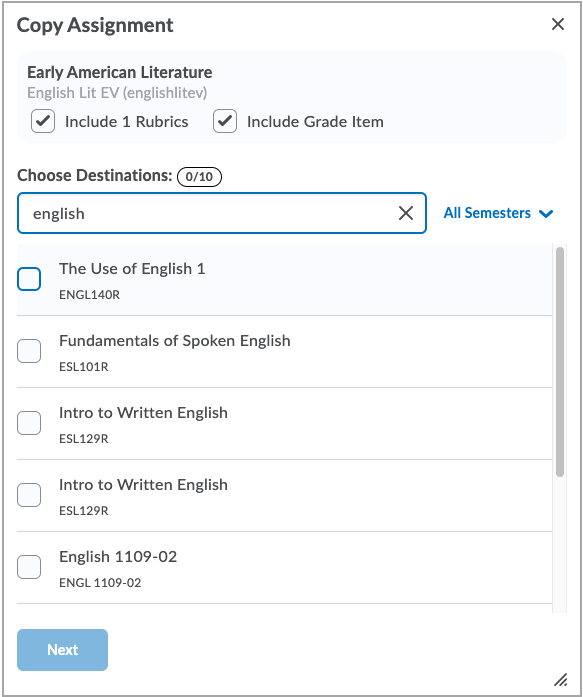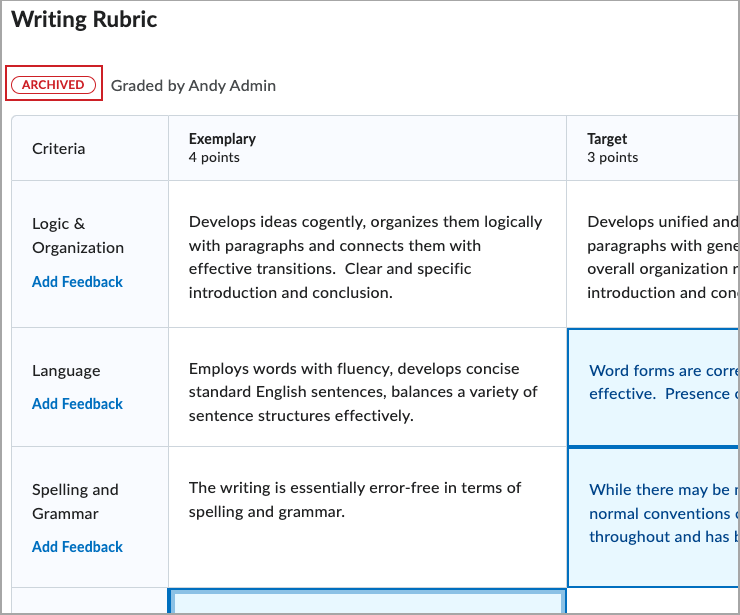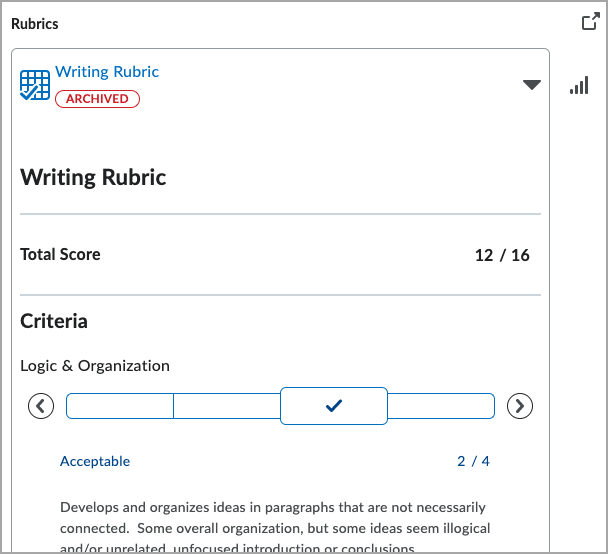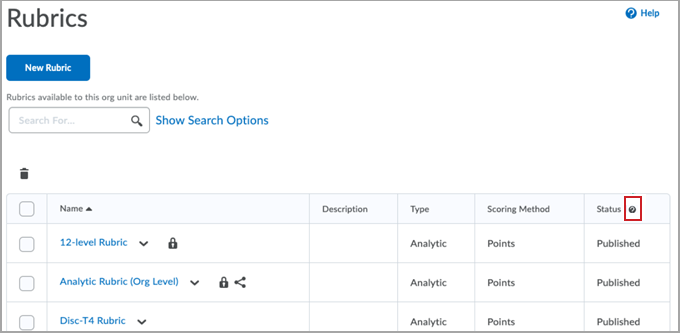This content was published: August 9, 2022. Phone numbers, email addresses, and other information may have changed.
June 2022 Highlights
Posted by Donna Swanson | Start the discussion
D2L Brightspace updates for June 2022 was installed on Thursday, June 23rd, 2022
This month’s updates for D2l Brightspace Include:
- Assignments – Save time by copying assignments to other courses you teach | New
- Brightspace Pulse – Pulse App now only supported on Android 6 / iOS13 and above | Updated
- Classlist – View user pronouns next to names to further personalize learning | Updated
- Manage Files – New/Edit File workflow change | Updated
- Rubrics – Quickly determine a Rubrics state with archived tags and selection list descriptions | Updated
Assignments – Save time by copying assignments to other courses you teach | New
Instructors who teach several courses and have the new Assignments > Copy to Other Courses permissions are now able to copy assignments between their courses. The copied assignment includes the following key assignment properties:
- Assignment folder and properties, including instructions, assignment category, and visibility
- Assignment properties including description, attachments (direct file attachments, uploaded from Google Workspace or OneDrive, and audio and video files), and category
- Grade item and grade category
- Availability dates
- Submission and completion information, including the Optional Grade item and the course scheme if used.
- Rubric(s) associated with the assignment. When copying an assignment that uses a shared rubric, instead of linking a copied assignment to a shared rubric, the rubric is also copied. The copied assignment links to the copied rubric. If an assignment uses a rubric that is archived, the rubric is copied and retains the archived state in the destination courses.
The following attributes are not copied:
- Instruction quicklinks and attachment resources created with the Attach link to existing activity action.
- Instruction images added using Insert Image that were saved to course files.
- Availability Release conditions and special access settings
- submission and completion information including group assignment designation.
- Evaluation and Feedback information including Turnitin associations, competency, and outcome associations.
- Content topic associations (for example, if the assignment is linked from content)
NOTE: In some cases, references to links and images that are not copied may result in broken links.
The Copy to Other Courses option appears in the context menu of assignments.
Figure: The Copy Assignments dialog enables you to select the associated rubrics and grade items and choose destinations.
In the Copy Assignment dialog, you can select any rubrics and grade items associated with the selected assignment to include them in the copy package. The Choose Destinations area enables you to search by keyword or semester to find the destination courses for the assignment. Only course offerings for which a user has the Copy to Other Courses permission appear in the Choose Destinations list. By default, the maximum number of courses you can select is 10.

The Copy Assignments dialog enables you to select the associated rubrics and grade items and choose destinations.
After you have completed the Copy Assignment dialog, the progress page indicates the status of each destination course and any issues. If you navigate away from the progress page, a minibar notification in Brightspace Learning Environment indicates when the assignment has been copied to all the destination courses. You can click the notification to open the progress page to review the status and logged issues.
Brightspace Pulse – Pulse App now only supported on Android 6 / iOS13 and above | Updated
With this release, the Brightspace Pulse App is now only supported on the following mobile operating systems:
- Android 6 and above
- iOS13 and above
This ensures that mobile level support is consistent across all D2L Apps, rather than being on a per-app basis; and consistent with Android and Apple policies concerning operating system support.
Previously, Brightspace Pulse was supported on Android 6 and iOS12 and above.
Classlist – View user pronouns next to names to further personalize learning | Updated
Classlist can now display users’ pronouns next to their names
Users with the existing Set My Pronouns permission enabled for their role can choose whether to display their pronouns to other users in the Account Settings > Pronouns menu. They must check the Allow others to see my pronouns check box for their pronouns to display in Classlist. Users must have the existing See Pronouns permission enabled for their role to see their classmates’ pronouns in Classlist.
Previously, the only location where pronouns displayed was in a user’s profile card.

Pronouns display in the ‘Last Name, First Name’ column of Classlist, to the right of the user’s name, in parentheses. User name text is blue, pronoun text is grey.
Manage Files – New/Edit File workflow change | Updated
Currently, when choosing the New File or Edit File option from Manage Files, users see a dialog open that must be moved or expanded to become properly visible. If users attempt to use the advanced code editor (source code editor), they open a second dialog that is not sized correctly and cannot be resized due to constraints from the first dialog.
Now, the New File and Edit File options in Manage Files open in a new tab in the user’s browser in order to support more efficient editing. By allowing the editor to open in a new tab, the advanced code editor dialog now opens fully.
Rubrics – Quickly determine a Rubrics state with archived tags and selection list descriptions | Updated
To provide consistency with other Rubrics experiences and build on the value of the Rubrics tool, there are several improvements in this release.
Archived Rubrics now appear with an archived tag
The Archived tag enables users to update rubric versions while keeping the existing evaluation records available for instructors and learners to review. Previously, when you changed a rubric, previous evaluations were removed. Now, if you change the status of a rubric to Archived, there are no effects on the alignment of rubrics to any assessment activities or previous evaluations that were completed using the rubric. Rubrics that are changed to an Archived status after the initial alignment to the activity continue to display and can be used for evaluation. There is a new Archived tag that appears on rubric tiles in activity creation and activity evaluation workflows to provide information to instructors and course developers that a rubric previously aligned to an activity is now archived. The Archived tag appears in both full-screen and pop-out views of the rubric in Grades, Competencies, and in the Consistent Eval experience. In addition, it appears in rubrics results pages and during evaluation for instructors in collapsed, expanded, and full-screen view. You cannot add archived rubrics to assessment activities and new rubric alignments – this behavior has not changed.
Note: The archived state tag is not visible to learners. If you have been evaluated using an archived status rubric, the learner can see those evaluations and feedback.
Rubric descriptions now appear in the Rubric picker list
The Rubric selection dialog window now includes the first two rows of the rubric description to enable instructors and course designers to better identify the version of a rubric when its name is being reused for a current rubric.
The help description for Status in the Rubrics tool now more clearly explains the interaction of archived status rubrics
The help text icon now appears next to the Status column heading, and the Archived Status text now more accurately reflects the available interactions with archived status rubrics. Specifically, it expands the description to indicate that archived rubrics do not appear in default search results and cannot be added to activities; however they can be evaluated. Further, archiving a rubric does not remove it from activities or published feedback.

The Archived tag appears under the Rubric title.

The Archived tag in the Rubrics list of Consistent Evaluation.

The Archived tag in the Rubrics detail view of Consistent Evaluation

The new location of the help icon in the Rubric Status column.

Start the discussion
PCC offers this limited open forum as an extension of the respectful, well-reasoned discourse we expect in our classroom discussions. As such, we welcome all viewpoints, but monitor comments to be sure they stick to the topic and contribute to the conversation. We will remove them if they contain or link to abusive material, personal attacks, profanity, off-topic items, or spam. This is the same behavior we require in our hallways and classrooms. Our online spaces are no different.